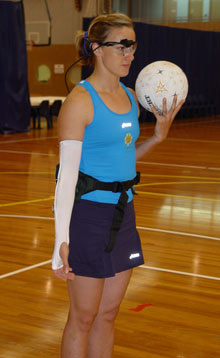A Training Tool for Athletes
A high-tech armband is helping athletes find their rhythm on the basketball court by playing a special tune when the athletes move their arms correctly. The “interactive throwing sleeve” extends from the knuckles to above the elbow and is form fitting, like a compression garment. It has two sensors, one at the wrist and another at the elbow, that are connected by thin conductive fibers. As the athlete shoots the ball, the sleeve measures the position, velocity, and acceleration of the arm. The information is wirelessly transmitted to a laptop so that the athlete can be monitored in real time.

Researchers at the Commonwealth Science and Industrial Research Organization (CSIRO) developed the device as a training tool to improve an athlete’s skills. “Shooting is a rhythmically based skill,” says Richard Helmer, a research engineer at CSIRO and the lead designer of the sleeve. When an athlete takes a shot, the typical motion is to pull the arm back before throwing it forward, says Helmer. But the exact pattern of movement that translates into a perfect shot can vary among players. So first, the researchers must establish the athlete’s correct movement pattern and assign tones to different joint angles. Once the system is properly programmed, the armband will track the player’s movement and play the corresponding tones, says Damian Farrow, a senior skill acquisition specialist at the Australian Institute of Sport (AIS). Farrow is working with CSIRO researchers to test the device on elite netball players. (Netball is an Australian sport similar to basketball, but played only by women.)
The more the athlete uses the device, the more she will start to recognize the pattern of tones associated with a successful shot.
This “novel feedback mechanism” for athletes “seems to fuse all the right things together,” says Jeff Chu, the vice president of engineering at Simbex, a Lebanon, NH-based research and product-development company that specializes in biomechanical feedback systems. The device provides accurate feedback, Chu says, without getting in the athletes’ way.
Multimedia
See the device in action and hear how it works.
The sleeve is made out of nylon Lycra, a stretchy spandex material, and looks like a long, fingerless glove. The two small sensors are custom made by CSIRO and built into the sleeve at the wrist and elbow. The sensors are connected by thin, conductive fibers that expand and contract as the arm flexes and extends, which, in turn, changes the electrical resistance of the fiber. The sensors pick up any changes in resistance and transmit the information wirelessly to a computer that calculates the distance between the joints and the kinematics of the arm. Graphs and charts of the action can be displayed within 20 milliseconds.

Helmer has synchronized the auditory information with the arm and wrist movements of the throw so that when an athlete makes the correct joint angles, the system plays the appropriate sounds.
Farrow says the researchers are tracking the kinematic data over time to create player profiles. “We can look at how to improve [a player’s] skills and also analyze the influence of other performance factors, like fatigue,” he says.
“The basic premise of providing biofeedback certainly has its merit in performance,” says Scott McLean, an assistant professor of kinesiology at Southwestern University in Georgetown, TX. “And the technology is small and unobtrusive enough to be built into any garment,” says McLean.
Farrow says the technology could be developed into a whole bodysuit. Indeed, Helmer would like to use it on a pair of running shorts.
The researchers have tested the sleeve on six netball players and are also working with a handful of athletes at AIS. Helmer says they would like to eventually commercialize the technology, but first need to do more testing.
Keep Reading
Most Popular
Large language models can do jaw-dropping things. But nobody knows exactly why.
And that's a problem. Figuring it out is one of the biggest scientific puzzles of our time and a crucial step towards controlling more powerful future models.
How scientists traced a mysterious covid case back to six toilets
When wastewater surveillance turns into a hunt for a single infected individual, the ethics get tricky.
The problem with plug-in hybrids? Their drivers.
Plug-in hybrids are often sold as a transition to EVs, but new data from Europe shows we’re still underestimating the emissions they produce.
Stay connected
Get the latest updates from
MIT Technology Review
Discover special offers, top stories, upcoming events, and more.